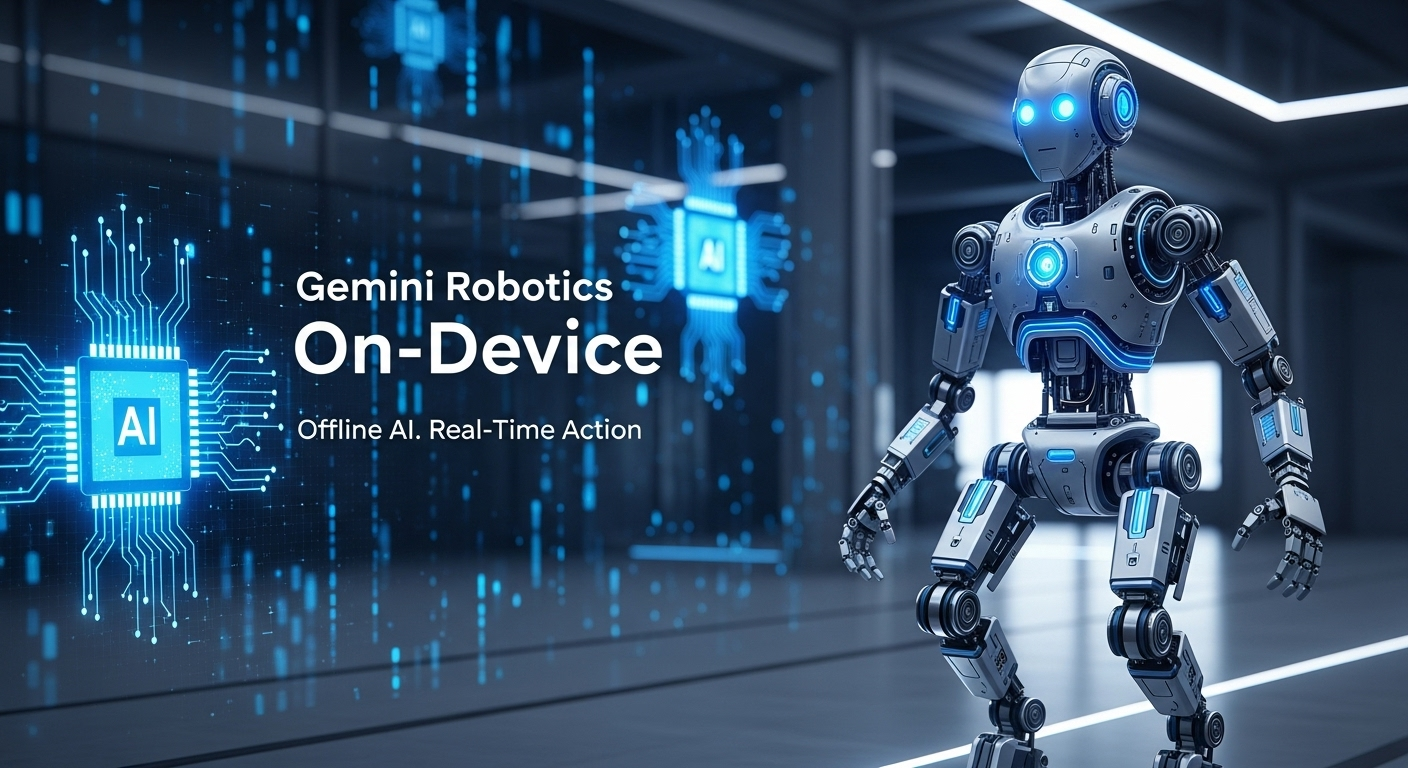On June 24th, 2025, Google DeepMind unveiled a robotics breakthrough that could redefine how autonomous machines operate. Led by Karolina Parda and her team, DeepMind introduced Gemini Robotics On-Device, a compact and powerful variant of its Gemini 2.0 model—engineered to run entirely offline. Unlike cloud-dependent systems, this version does not need Wi-Fi, internet access, or remote servers. It runs directly on the robot, enabling real-time thinking and action on factory floors, in homes, or even deep-space missions.
Table of Contents
ToggleA Brain Without a Leash
Traditional robotic models often rely on cloud-based reasoning, introducing delays due to network latency and external processing. Gemini Robotics On-Device cuts this tether. It functions entirely offline, allowing robots to perceive, plan, and act instantly. This design opens new possibilities for robots operating in connectivity-challenged environments such as industrial warehouses, offshore rigs, or remote terrains.
To enable this, DeepMind engineers streamlined the model architecture to fit dual ARM Aloha rigs, maintaining critical functionalities like vision transformers, language encoders, and action decoders—all packed into an embedded format. The model runs on compact GPU boards designed for mobile robots, not bulky server racks, allowing decision-making within tens of milliseconds, as opposed to hundreds.
Performance That Rivals the Cloud
DeepMind released comparative performance benchmarks showing that Gemini Robotics On-Device nearly matches its hybrid cloud-assisted counterpart across various metrics, including:
-
Visual generalization
-
Semantic understanding
-
Behavioral flexibility
In benchmarks involving unseen objects or odd lighting, it outperformed all previous on-device models. In instruction-following tests—particularly those with multi-step, natural language commands—the model narrowed the performance gap to the hybrid version, which still benefits from cloud computing power.
Real-World Applications with Minimal Training
Demonstrations include tasks like:
-
Unzipping soft lunch boxes
-
Folding creased shirts
-
Pouring liquid into narrow containers
-
Sliding a card out of a deck
All these tasks were learned from just 50–100 demonstrations, not the thousands typically needed. This dramatically reduces the time, cost, and expertise required to train new robotic skills—making high-functioning automation accessible to smaller labs and startups.
Portability and Adaptability Across Platforms
One of the most impressive aspects of Gemini Robotics On-Device is its embodiment-agnostic architecture. DeepMind initially trained the model on its internal Aloha platform, then ported the same weights (with minor adaptation) to entirely different robots:
-
Franka FR3 BARM Workstation, which then assembled belt drives and folded delicate clothing.
-
Aptronics Apollo Humanoid, which followed voice commands and manipulated previously unseen household objects.
This portability indicates that once trained, skills can be shared across robotic platforms with minimal overhead—a major leap toward universal robot skill libraries.
Developer Tools and Custom Training
Developers can engage with the system through the Gemini Robotics SDK, which includes:
-
Interface code for live robots
-
Support for the MuJoCo simulator
-
Compatibility with common frameworks like Icing or RoboSuite
-
Scripts to convert demonstration data into the required format
Because this is the first on-device model from Google to support local fine-tuning, developers can optimize models for specific tasks without waiting for centralized updates. Training new tasks—like icing cupcakes or packaging unique products—can happen entirely offline on a local machine and be deployed directly to the robot’s flash storage.
Prioritizing Safety and Responsible Deployment
Robots, especially those operating near humans, require robust safety systems. DeepMind integrates multiple protective layers into the on-device stack:
-
Semantic filters that detect unsafe instructions (e.g., handing a knife blade-first)
-
Low-level controllers monitoring torque, collision cones, and velocity
-
Semantic safety benchmarks to stress-test models with ambiguous or conflicting tasks
-
Oversight from internal responsibility councils and ethics teams
This meticulous approach ensures that models operate safely before they’re widely deployed, especially in unpredictable real-world environments.
Why Offline Robots Matter
This shift toward on-device intelligence addresses several real-world challenges:
-
Connectivity gaps in industrial warehouses, hospitals, or off-planet missions
-
Data sovereignty requirements in defense or finance sectors
-
Cost reduction, as recurring cloud compute and data security audits are minimized
-
Precision and latency, especially in tasks requiring sub-millimeter accuracy
By embedding intelligence directly into the robot, DeepMind achieves motion and perception feedback loops that are faster and more reliable—crucial for high-precision manufacturing or complex dexterous manipulation.
Future-Proofed for Embedded Hardware
Although current implementations rely on dual ARM Aloha rigs, the architecture is designed to scale further. As embedded hardware improves—through platforms like NVIDIA Orin, Qualcomm SOCs, or custom ASICs—Gemini Robotics On-Device can shrink in footprint and grow in capabilities.
Final Thoughts
Gemini Robotics On-Device represents a foundational shift in robotics. It brings the intelligence, agility, and adaptability of multimodal AI into compact, fully offline form factors. As industries increasingly seek autonomous solutions that don’t depend on cloud connectivity, this technology positions DeepMind at the forefront of real-time, decentralized robotic intelligence.
With its robust safety layers, developer tools, and multi-platform adaptability, Gemini Robotics On-Device could soon power the next generation of robots in warehouses, hospitals, homes—and beyond.
